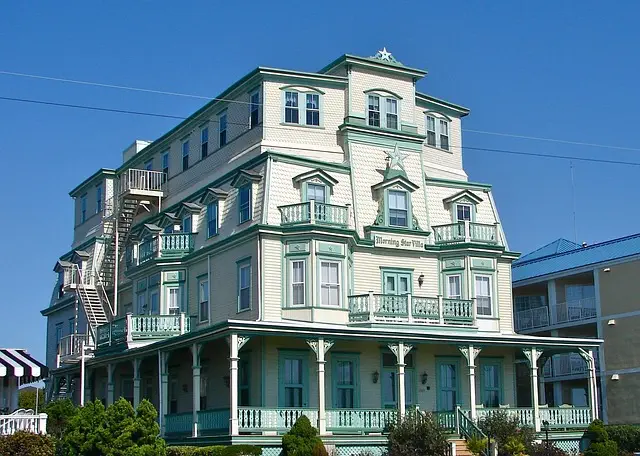The Cape May Lighthouse, constructed in 1879 in Cape May County, New Jersey, is a historic landmark that reflects the area's transformation from a fishing village to a seaside resort. This iconic structure, with its distinctive conical shape and white limestone construction, has served as a crucial navigation aid for ships entering Cape May Harbor, evolving alongside technological advancements. Today, it attracts global visitors eager to experience its historical significance and panoramic views, while conservation efforts ensure its enduring legacy.
“Discover the enchanting Cape May Lighthouse, a beacon of history and navigation nestled on the southern tip of Cape May Point, NJ. This iconic landmark stands tall as a testament to human ingenuity and coastal resilience in beautiful Cape May County. From its rich historical background to its architectural marvels and vital role in local navigation, this guide explores every facet of this beloved New Jersey treasure.”
- Historical Background: A Iconic Landmark in Cape May County
- Architecture and Design of the Lighthouse
- The Lighthouse's Role in Navigation and Safety
- Visiting the Cape May Lighthouse: What to Expect
- Local Legends and Stories Associated with the Lighthouse
- Conservation and Preservation Efforts for the Future
Historical Background: A Iconic Landmark in Cape May County

The Cape May Lighthouse stands as an iconic landmark in Cape May County, New Jersey, with a rich historical background that dates back to the 19th century. Built in 1879, this lighthouse is not just a beacon for sailors but also a symbol of resilience and community spirit. It has witnessed the evolution of Cape May from a small fishing village to a vibrant seaside resort, enduring through wars, technological advancements, and changing maritime needs.
The lighthouse’s construction was a significant achievement, given the challenges posed by its coastal location. Over the years, it has served as a vital navigation aid, guiding ships safely into Cape May Harbor. Today, it remains an integral part of the local community, attracting visitors from around the world who come to appreciate its historical significance and breathtaking views.
Architecture and Design of the Lighthouse

The Cape May Lighthouse, located at Cape May Point in Cape May County, New Jersey, stands as a stunning example of 19th-century lighthouse architecture. This iconic structure is characterized by its distinctive conical shape and white limestone construction, designed to withstand the elements and guide ships safely to shore. Its design reflects the classical style popular during that era, featuring a robust base that tapers upwards to a lantern room at the top, where powerful beams of light once shone.
The lighthouse’s exterior is marked by its smooth, curved walls and uniform white coloring, making it a prominent feature against the Atlantic Ocean’s backdrop. Inside, a spiral stone staircase ascends to the beacon, while various rooms accommodate the living quarters for the lighthouse keeper and their family. This blend of functionality and aesthetic appeal showcases the skill and craftsmanship of the era, contributing to the lighthouse’s enduring status as a symbol of Cape May County’s rich maritime history.
The Lighthouse's Role in Navigation and Safety

The Cape May Lighthouse, standing tall on Cape May Point in New Jersey, has been a beacon of guidance and safety for sailors since its construction in 1879. As a vital navigation aid, it plays a crucial role in ensuring the security of maritime travel along the coast of Cape May County. With its consistent beam of light, the lighthouse guides ships through treacherous waters and dangerous storms, enabling them to navigate safely into port.
The lighthouse’s strategic location at the southern tip of New Jersey allows it to serve as a critical reference point for mariners entering or exiting Delaware Bay. Its automated system, powered by solar energy, ensures that the light remains operational day and night, year-round, providing a consistent visual signal for ships at sea. This historical landmark not only aids in navigation but also serves as a reminder of the region’s rich maritime history, welcoming visitors to explore its charm while ensuring the safety of those who traverse these waters.
Visiting the Cape May Lighthouse: What to Expect

Visiting the Cape May Lighthouse is a journey back in time, offering a glimpse into the history and beauty of Cape May County, New Jersey. Located at the southern tip of the state, this iconic structure stands tall on a bluff overlooking the Atlantic Ocean, providing both scenic views and rich cultural experiences. Tourists can expect a well-preserved lighthouse with a fascinating history, dating back to its construction in 1879. The climb up the spiral staircase offers panoramic views of the surrounding area, from the beach to the bay, making it a must-visit attraction for both locals and visitors alike.
Upon arrival, guests are greeted by the lighthouse keeper’s house and various exhibits that showcase the life of early keepers and the evolution of lighthouse technology. Interactive displays and historical artifacts provide an engaging learning experience, while the opportunity to step inside the lighthouse itself is a highlight for many. The journey up the tower culminates at the lantern room, where visitors can appreciate the breathtaking vistas and understand the vital role this lighthouse played in maritime navigation for generations.
Local Legends and Stories Associated with the Lighthouse

The historic Cape May Lighthouse stands as a beacon not only for sailors but also for the rich tapestry of local legends that have grown up around it over the centuries. In the heart of Cape May County, New Jersey, this iconic structure has witnessed countless stories and seen many mysterious occurrences. One popular tale speaks of a ghostly figure, said to be a former lighthouse keeper’s wife, who still wanders the grounds, her sorrowful spirit unable to find peace. Another legend tells of hidden treasures buried nearby by pirate ships that once sailed these waters, drawing treasure hunters and adventurers to the area for decades.
These tales reflect the allure of the Cape May Lighthouse, which has captivated visitors and locals alike. The lighthouse serves as a tangible link to the past, inviting people to explore not only its architectural beauty but also the rich historical and mythical narratives that have been passed down through generations. Whether these stories are true or mere folklore, they contribute to the enchanting atmosphere of this beloved landmark in Cape May County, New Jersey.
Conservation and Preservation Efforts for the Future

The Cape May Lighthouse, a historic landmark in Cape May County, New Jersey, has been the subject of extensive conservation and preservation efforts to ensure its longevity for future generations. These initiatives are crucial in protecting not just the lighthouse structure but also the rich history and cultural significance it holds. Local communities, historical societies, and various organizations have joined forces to safeguard this iconic symbol against the effects of time, weather, and human activity.
Through collaborative efforts, a comprehensive plan has been developed to preserve the lighthouse’s integrity while making it accessible to visitors. This includes restoring the tower, maintaining the original equipment, and implementing sustainable practices to minimize environmental impact. The focus is on balancing historical preservation with modern accessibility, ensuring that future tourists can enjoy this historic site without causing further deterioration. These conservation measures aim to educate visitors about the area’s rich past while also fostering a deep appreciation for the lighthouse as a cultural treasure in Cape May County, New Jersey.



